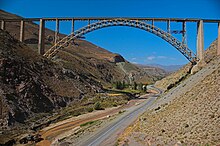Khoy
[7] Khoy was named in ancient times for the salt mines that made it an important spur of the Silk Route.
[8] Around the year 37 BC, Mark Antony had crossed the plain that is located between Khoy and Marand during one of the many and frequent Roman-Parthian Wars.
[8][page needed] By the first half of the 11th century the Byzantine emperors were actively trying to round off their eastern territories, in an attempt to absorb the unstable Armenian dynasties.
In 1021-2 emperor Basil II led his army as far as Khoy within 175 km of Dvin, and obtained the surrender of royalty from the Artsruni dynasty of Van.
[10] In 1210, the city was conquered by the forces of Kingdom of Georgia sent by Tamar the Great under the command of Zakaria and Ivane Mkhargrdzeli.
[14] In the wake of the demise of the Safavids, the Ottomans took Khoy on 6 May 1724, a territorial gain which was confirmed with Imperial Russia through the Treaty of Constantinople (1724).
[16] He noted further that in the villages around Khoy there were a few more, but the vast majority had migrated to the North of the Aras river following Russia's victory over Persia in 1828 and the encouraged settling in the newly incorporated Russian regions of Eastern Armenia.
The Kurds of this less, who live mostly in a nomadic way as opposed to the mostly settled Azerbaijanis, are largely Sunni and are composed of two independent tribes, Shakkak and Madrumi.


